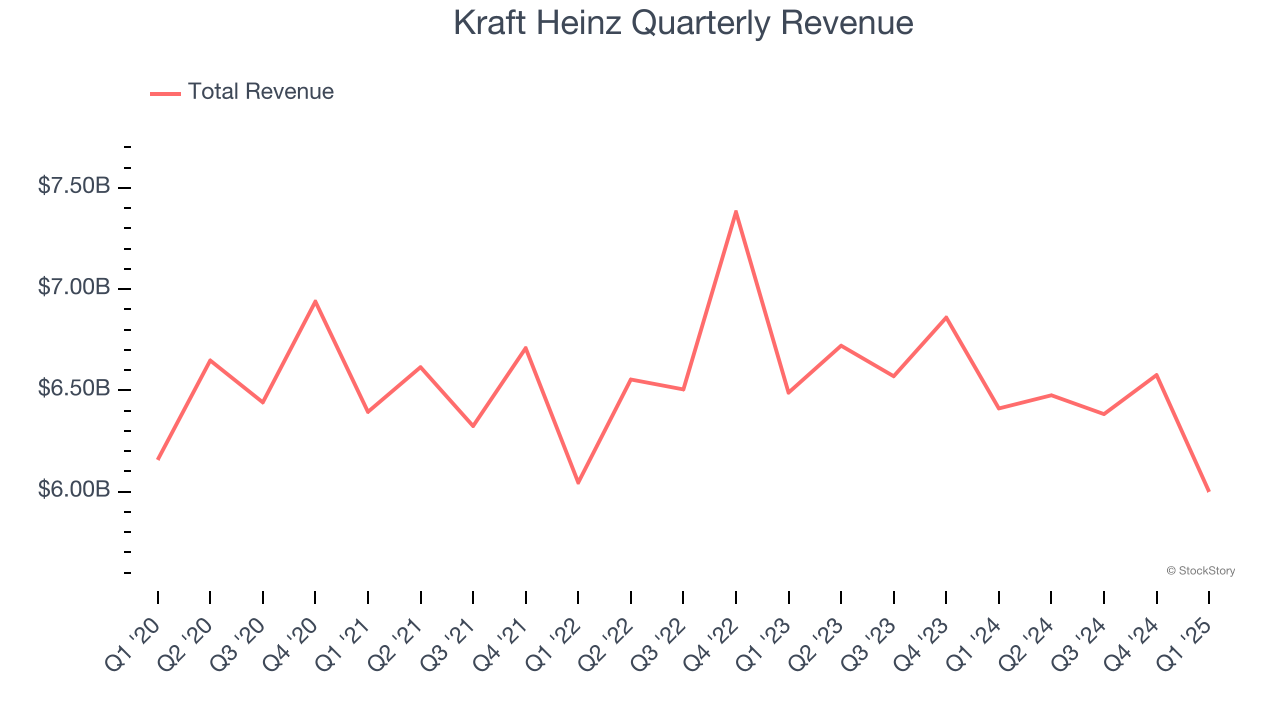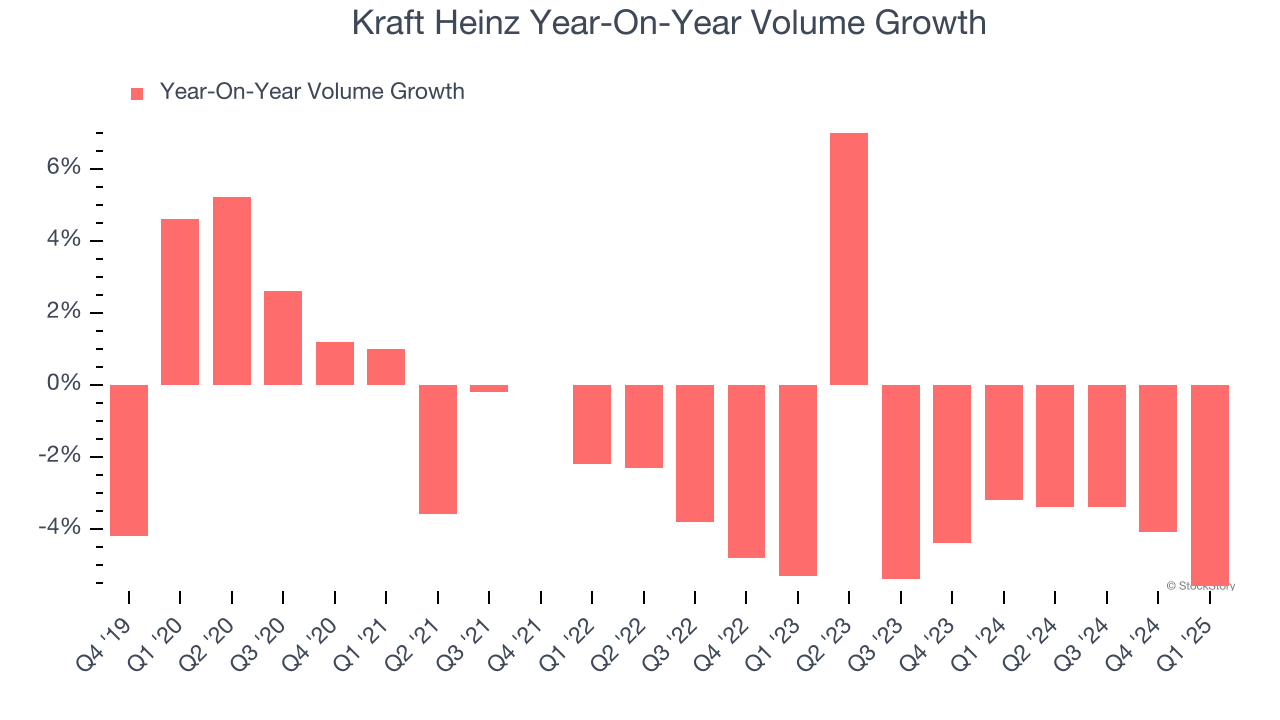
Packaged foods company Kraft Heinz (NASDAQ:KHC) met Wall Street’s revenue expectations in Q1 CY2025, but sales fell by 6.4% year on year to $6.00 billion. Its non-GAAP profit of $0.62 per share was 2.7% above analysts’ consensus estimates.
Is now the time to buy Kraft Heinz? Find out by accessing our full research report, it’s free.
Kraft Heinz (KHC) Q1 CY2025 Highlights:
- Revenue: $6.00 billion vs analyst estimates of $6.02 billion (6.4% year-on-year decline, in line)
- Adjusted EPS: $0.62 vs analyst estimates of $0.60 (2.7% beat)
- Adjusted EBITDA: $1.43 billion vs analyst estimates of $1.43 billion (23.8% margin, in line)
- Management lowered its full-year Adjusted EPS guidance to $2.59 at the midpoint, a 3.5% decrease
- Operating Margin: 19.9%, in line with the same quarter last year
- Free Cash Flow was -$166 million, down from $477 million in the same quarter last year
- Organic Revenue fell 4.7% year on year (-0.5% in the same quarter last year)
- Sales Volumes fell 5.6% year on year (-3.2% in the same quarter last year)
- Market Capitalization: $34.38 billion
Company Overview
The result of a 2015 mega-merger between Kraft and Heinz, Kraft Heinz (NASDAQ:KHC) is a packaged foods giant whose products span coffee to cheese to packaged meat.
Sales Growth
A company’s long-term performance is an indicator of its overall quality. Any business can experience short-term success, but top-performing ones enjoy sustained growth for years.
With $25.43 billion in revenue over the past 12 months, Kraft Heinz is one of the most widely recognized consumer staples companies. Its influence over consumers gives it negotiating leverage with distributors, enabling it to pick and choose where it sells its products (a luxury many don’t have). However, its scale is a double-edged sword because there are only a finite number of major retail partners, placing a ceiling on its growth. For Kraft Heinz to boost its sales, it likely needs to adjust its prices, launch new offerings, or lean into foreign markets.
As you can see below, Kraft Heinz struggled to increase demand as its $25.43 billion of sales for the trailing 12 months was close to its revenue three years ago. This is mainly because consumers bought less of its products - we’ll explore what this means in the "Volume Growth" section.

This quarter, Kraft Heinz reported a rather uninspiring 6.4% year-on-year revenue decline to $6.00 billion of revenue, in line with Wall Street’s estimates.
Looking ahead, sell-side analysts expect revenue to decline by 1.8% over the next 12 months, similar to its three-year rate. This projection doesn't excite us and indicates its products will see some demand headwinds.
Today’s young investors won’t have read the timeless lessons in Gorilla Game: Picking Winners In High Technology because it was written more than 20 years ago when Microsoft and Apple were first establishing their supremacy. But if we apply the same principles, then enterprise software stocks leveraging their own generative AI capabilities may well be the Gorillas of the future. So, in that spirit, we are excited to present our Special Free Report on a profitable, fast-growing enterprise software stock that is already riding the automation wave and looking to catch the generative AI next.
Volume Growth
Revenue growth can be broken down into changes in price and volume (the number of units sold). While both are important, volume is the lifeblood of a successful staples business as there’s a ceiling to what consumers will pay for everyday goods; they can always trade down to non-branded products if the branded versions are too expensive.
To analyze whether Kraft Heinz generated its growth (or lack thereof) from changes in price or volume, we can compare its volume growth to its organic revenue growth, which excludes non-fundamental impacts on company financials like mergers and currency fluctuations.
Over the last two years, Kraft Heinz’s average quarterly sales volumes have shrunk by 2.8%. This isn’t ideal for a consumer staples company, where demand is typically stable.

In Kraft Heinz’s Q1 2025, sales volumes dropped 5.6% year on year. This result represents a further deceleration from its historical levels, showing the business is struggling to move its products.
Key Takeaways from Kraft Heinz’s Q1 Results
We struggled to find many positives in these results. The company's organic revenue fell short of Wall Street’s estimates and full-year EPS guidance missed after being lowered. Overall, this was a weaker quarter. The stock traded down 1% to $28.49 immediately after reporting.
The latest quarter from Kraft Heinz’s wasn’t that good. One earnings report doesn’t define a company’s quality, though, so let’s explore whether the stock is a buy at the current price. When making that decision, it’s important to consider its valuation, business qualities, as well as what has happened in the latest quarter. We cover that in our actionable full research report which you can read here, it’s free.
